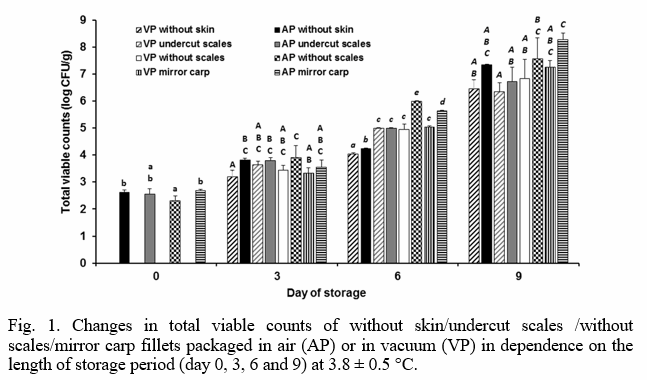EFFECT OF DIFFERENT TYPES OF DESCALING METHODS ON SHELF LIFE OF AIR/VACUUM PACKAGED COMMON CARP (CYPRINUS CARPIO L.) FILLETS UNDER REFRIGERATED STORAGE CONDITIONS
Introduction
Common carp (Cyprinus carpio L.) is the major freshwater fish species traditionally farmed in ponds of Central and Eastern Europe Stibranyiova and Adamek (1998). Czech market is seasonal and 65 % of carp production is sold during the Christmas season therefore it is necessary to look for solutions how to increase the demand of customers to buy carp and how to increase consumption throughout the whole year. There are many factors that affect freshness parameters of fish flesh, for example: handling during harvesting, age of the fish, correct slaughtering method, evisceration and cleaning of the abdominal cavity, methods of fish processing, time of processing and storage temperature during handling Gates (2011). In fish, the fastest spoilage tissues are gills, intestine and skin surface, where bacteria colonizing these tissues start to replicate rapidly after the fish death Shamsuzzaman et al. (2011). With regard to common carp, only a few studies have been reported. Fish surface (skin, scales) can be processed by various methods as descaling, skin removal with a very little information published on carp flesh. In the case of scaly fish, the scales are usually removed by different descaling machines or by hand with descaler. During descaling, only the scales are removed, but the corium which consists of "scale beds" is remained. These pockets contain residues of mucus which supports the development of bacterial growth Gram and Huss (1996); Gram et al. (2002).
Materials and methods
Forty fish (2227 ± 362 g) were randomly selected (30 scaly, 10 mirror) and divided into four experimental groups (n = 10). Fish from each group were descaled with different type of descaling technique according to the experimental group. Four different treatments and descaling techniques were applied: first group "without skin" - skin was completely removed; second group "undercut scales" - scales were undercut with sterile knife; third group "without scales" - only scales were removed with descaler; and fourth group "mirror carp" -fillets of mirror carp with skin. First group (left fillets, 476 ± 75 g) was used for microbiological analyses and second group (right fillets, 459 ± 76 g) for sensory analyses. Packed fillets for microbiological and sensory analyses were stored in straight horizontal position separately. One piece of each fillet was taken each third day and sensory and microbiological analyses were performed on days 0, 3, 6 and 9.
Results
Figure 1 shows TVC (log CFU/g) changes in AP and VP carp fillets of four experimental groups during storage. Microbial communities grew to between 3.19 - 3.90, 4.03 - 6.00 and 6.35 - 8.28 log CFU/g after 3, 6 and 9 days of storage, respectively and fillets without skin showed the lowest TVC among all analysed groups throughout storage. From sensory evaluation, fillets with undercut scales and without skin reached the best sensory scores and indicated their preferences among panel of selected assessors.
Discussion and conclusion
Compared to other studies Zhang et al. (2015) about microbiological changes in common carp flesh, the spoilage potential was slower and extended shelf life up to 9 days (present study). Zhang et al. (2015) reported significantly higher TVC of AP as well as VP carp fillets with 8.67 and 6.38 log CFU/g after 6 days of storage probably affected by treatment in different season (September compared to January in our study) and slightly higher storage temperature of samples at 4 ± 1 °C in comparison with 3.8 ± 0.5 °C in present study. Sensory analyses showed that consistency and odour of carp fillets were influenced by packaging conditions as well as descaling methods. This can be explained by the fact that flesh without skin or undercut scales is partly devoid of mucus.
The study was financially supported by the Ministry of Education, Youth and Sports of the Czech Republic - projects „CENAKVA" (No. CZ.1.05/2.1.00/01.0024), "CENAKVA II" (No. LO1205 under the NPU I program), by the Grant Agency of the University of South Bohemia in České Budějovice (No. 060/2016/Z), by the Ministry of Agriculture of the Czech Republic (No. QJ1510119).
References
Gates K.W. 2011. Handbook of Seafood and Seafood Products Analysis. In: Leo M.L. and F.T. Noller (Eds) Journal of Aquatic Food Product Technology 20(2):258-269
Gram L. and H.H. Huss. 1996. Microbiological spoilage of fish and fish products. International Journal of Food Microbiology 33(1): 121-137.
Gram L., L. Ravn, M. Rash, J.B. Bruhn, A.B. Christensen and M. Givskov. 2002. Food spoilage - interactions between food spoilage bacteria. International Journal of Food Microbiology 78(1-2): 79-97.
Stibranyiova I., Z. Adamek. 1998. The impact of winter storage of live carp on discharge water quality. Journal of Applied Ichthyology 14: 91-95.
Shamsuzzaman M.M., S.K. Mazumder, M.A. Siddique and M.N.U. Miah. 2011. Microbial quality of hilsa shad (Tenualosa ilisha) at different stages of processing. Journal of Bangladesh Agricultural University 9(2): 339-344.
Zhang Y., Q. Li, D. Li, X. Liu and Y. Luo. 2015. Changes in the microbial communities of air-packaged and vacuum-packaged common carp (Cyprinus carpio) stored at 4 ⁰C. Food Microbiology 52: 197-204.
